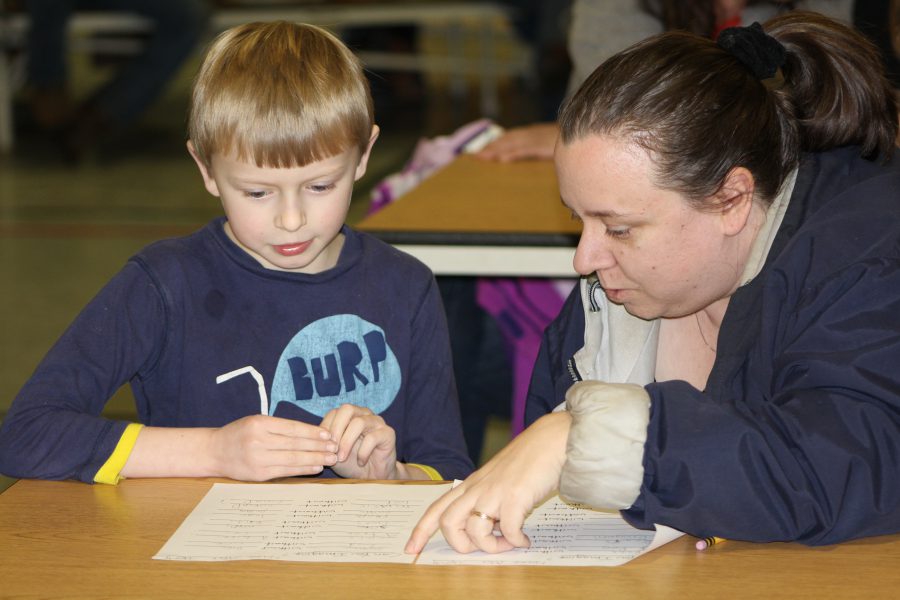
Helping reluctant and struggling readers may be the hardest, but perhaps the most important, reading-related issue for many parents. However, take comfort that there is help! The first thing you may need to know is that, just as infants learn to walk at different times in their lives, children learn to read at different times in their lives, too. There is no need to compare your child to other siblings in the family or other children at school. Learning to read will come, and sometimes the light bulb goes on and the reading success comes together at the least expected times.
Reluctant or struggling readers may fall into three categories: those who cannot read, those who can read and choose not to, and those who can read but can’t find anything interesting to read. For students who cannot read, remember the importance of the read-aloud. Reading truly starts with positive attitudes, and the read-aloud addresses those positive attitudes. There are many high-quality picture books available now with more advanced themes for older readers. Such books are wonderful options for the read-aloud.
Children who see reading as an important and fun activity will also see it as something worth working for. Those children who see reading as something they will someday be able to do will also work hard with parents and teachers to learn how to do it. You have an extremely important part to play in that attitude. If you can simply send your child to school with the proper attitude, then your child’s teacher can take over with direct instruction and formal lessons. Success will someday come along.
Remember that reading starts with phonemic awareness. All successful readers have mastered those skills. It is possible that children still learning to read well, no matter what the age or grade, may need to work on securing phonemic awareness skills. Return to that part of the reading process if necessary. Children who are still learning to read well, no matter what the age or grade, may also need to review phonics skills. Work on that part of the reading process with your child as needed, too.
It is important with reluctant and struggling readers to determine the cause of the struggling. Is the reader having trouble reading on-level books? Is the reader having trouble with vocabulary, comprehension, or fluency? Ask your child’s teacher for assessment information, and learn which of these particular parts of the reading process are causing problems. In many cases, the problem will be a combination of several elements. However, instead of addressing all of the reading problems at once, concentrate on one or two reading strategies at a time, perhaps something to reinforce what is being taught at school. The extra practice and help at home will make a difference.
Don’t give up! The more exposure children get to reading, the better. The shared reading activity, mentioned earlier, has a lot of additional benefits for the reluctant and struggling readers. First of all, the reading materials that have a higher level text for adults and a lower level text for children offer a substantial and complete text. These are not the typical decodable texts and are not perceived as baby books. Second, children who are below level sometimes do not read because the materials do not interest them. Look into “Hi-Lo” books. These books are high interest mixed with lower level vocabulary, compelling storylines, straightforward plots, credible characters, and simple sentence structures. Stop and ask a librarian, or do a simple search for “Hi-Lo books” for more information on these kinds of books. (Schoolonwheels.org put together this helpful list of Hi-Lo books.)
Reflect upon what successful readers do. These readers take control of their reading. They use strategies to help them succeed. Yes, there are some fortunate children who learn to read almost automatically, but most readers work at it. Encourage your reluctant and struggling reader to sit up when reading, follow along with a finger when reading, use letter clues, use picture clues, and read for meaning.
What else do good readers do? They practice. When good readers practice, they gain more exposure to strategy usage such as letter clues; looking for smaller words within words, beginnings and endings, common sounds like the letter c making the letter /k/ sound, uncommon sounds like the letter g making the letter /j/ sound; and read for meaning. These readers create mental pictures, use background knowledge, ask questions, make inferences, determine what’s most important, synthesize information, and make connections. Even strong readers have difficulty when reading challenging texts, but they recognize the difficulty, reread, and even use a dictionary, a computer, or other sources when needed. For clarification, strong readers take control when reading, and are engaged with the text. Encourage your reluctant or struggling reader to do the same.
With this population of readers, be on special alert for frustration. When reading becomes too frustrating, or too much work, you need to intervene, take some action, and do something to turn that situation around. Suggestions include offering sincere praise, giving a difficult word, modeling word attack strategies, taking over the reading, playing a related game, or stopping for the night.
Also for this population of readers, remember that it is all in the presentation. Fighting about reading will obviously bring more frustration and possible tears. Showing that you care, showing that you are on your child’s side, and showing that you sincerely want your child to succeed, will help to turn a reluctant and struggling reader into a successful reader. Remember that it’s all in the delivery. Be as cheerful and supportive as possible. Watch the tone in your voice. If you find yourself becoming frustrated too, then take a deep breath, change the tone in your voice, and try again. Remain as positive as possible.
For those who can read and choose not to read, it’s important to isolate why. Is reading no longer interesting? Is reading not important anymore? Is reading too difficult? Can the child read the words but not understand the meaning? Talk with your child about his or her reading problems. You may be surprised by what you hear. It may be something unrelated to reading, such as your child missing the read-aloud time with you. It may even be something rather simple, such as your child having trouble seeing the words in print, so have the eyes checked for corrective vision.
Continue with the read-aloud. It works. This will most likely be the most important action you can take to help your child get (back) into the reading habit. If, at any age, your child seems to have lost interest in reading, there is no need to make a major issue of it. Start with the newspaper comics or a graphic novel, or the Guinness Book of World Records. These are great opportunities to reconnect. Make a special effort to find books or magazines on subjects that may interest your child. Leave them around the house within easy reach. You may also need to share what you are reading, as well as your overall reading interests, with your child. Show that reading can be an enjoyable activity.
Do you have boys who seem to have lost interest in reading forever? Boys are more inclined to read informational texts, magazines, newspaper articles, and comic books or graphic novels. They are also more likely to read about hobbies, collections, sports, and things they enjoy doing. Please note that some of these suggested texts are not complete books, but instead are parts of larger pieces of works. That’s fine. The goal is to entice a reluctant and struggling reader back into the reading habit. That may involve reading parts of larger pieces of works.
Pay attention to what your boy chooses for reading material. It may be non-fiction, science fiction, or fantasy. It may also be a favorite author, or it may be something considered rather easy. It may even be a graphic novel. Find and provide these materials for him, and he may just turn around again. Keep trying and eventually a reluctant or struggling reader will be back to choosing reading out of preference.
Play reading and other games, too. The simple games of Scrabble, Memory, or Tic-Tac-Toe work well. With other games, encourage your child do as much of the reading as possible. In Monopoly, for example, your child can read all of the cards. That means her cards and your cards. Give yourself permission to be a bit ridiculous. Pretend you can’t read, that you left your glasses somewhere, or that you are too tired. Follow through with whatever it takes to increase reading time even a little bit more.
Remember the importance of praise. A little praise and encouragement goes a long, long way towards helping reluctant or struggling readers. Note that the praise needs to be genuine. You cannot tell a fragile reader that she is reading well when she is stumbling on every other word. You can, though, say something like “nice effort” or “good for you” on particular words. You can even share something exciting like “Wow, I would have had trouble on that word too!” Also, if a book is too hard, just get a new book. There is no need to wrestle through something that will only become a battle. There are many, many other choices.
It is most important to help those who can read but can’t find anything interesting to read to discover books they will enjoy. Do not assume that choosing books is an easy task. Consider these questions: Does your child have a book he likes to read over and over again? Then find more like them. Does your child have a favorite author? Find more books by the same author. Does your child like some specific characters or a series? Find more books from the same series. Check out what friends are reading, too. Librarians can be very helpful in finding books that will capture your child’s attention. (CLiF Note: Our book list, developed by our team of librarians, educators, and bookstore staff, can be helpful in finding good reads for your child’s level. Brightly is also one of our favorite sites that has a ton of book recommendations based on your child’s age, reading level, and interests).
In short, do whatever it takes to help your child find the books that are most attention-grabbing and appealing. Put yourself into your child’s shoes. Would you want to read something that no longer interests you? Most likely the answer is “No.” For that reason, look for those fascinating and noteworthy books, spend the necessary time at the library, ask friends about their favorite books, and try some. Do all you can do, and don’t give up. Keep trying, remain positive, and these problems will be resolved. These reluctant and struggling readers will become successful readers eventually.
10 Ways to Help Reluctant and Struggling Readers
- Determine the reason for the reluctance and struggling. Is it because the child can’t read, can read but chooses not to, or can read but can’t find anything interesting to read?
2. Remember to offer encouragement and positive praise. Make the encouragement and positive praise as genuine as possible.
3. Talk with your child about why he or she is no longer reading. The discussions may be revealing.
4. Remember the importance of the read-aloud. Returning to the read-aloud may help your child reconnect to reading.
5. Consider starting at the beginning of the reading process. Work on rhymes, blending, and letters.
6. Try to determine where the reading problems are. Work on vocabulary, comprehension, and/or fluency.
7. Is there a need for an eye exam?
8. Help your child find books that are most interesting.
9. Play some reading-related games like Scrabble, Scrabble Jr., and Upwords. Play other games and encourage your child to do all of the reading.
10. Ask your child to do some reading around the home. This includes reading recipes, writing the shopping lists, reading the directions to games, and looking up telephone numbers.
Bruce Johnson is an educator, reading specialist at the Merrimack Valley School District in New Hampshire, member of CLiF’s Advisory Board, and author of Helping Your Child Become a Successful Reader: A Guide for Parents. Learn more at www.guidesforparents.wordpress.com.



